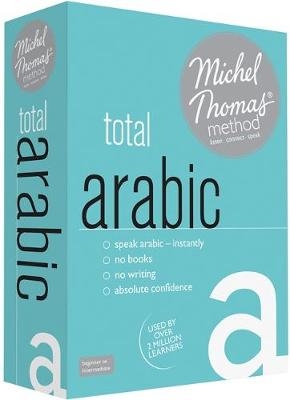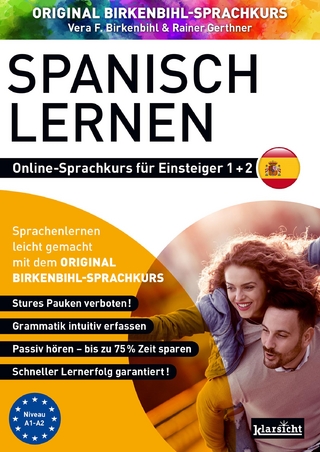
Total Arabic (Learn Arabic with the Michel Thomas Method)
John Murray Learning (Verlag)
978-1-4441-3802-3 (ISBN)
- Titel ist leider vergriffen;
keine Neuauflage - Artikel merken
Learn Arabic - Instantly.
No books. No writing. No memorizing.
? Join the millions of people worldwide who have learned a new language with the Michel Thomas Method. ?
"The nearest thing to painless learning" - The Times
- Guaranteed success. Speak and understand Arabic perfectly
- Incredible progress. Learn Arabic effortlessly
- Absolute confidence. Unleash your natural learning style without trying
The Method:
Stress-free audio learning
Michel Thomas teaches you Arabic through your own language, so there's no stress, and no anxiety. He builds it up, step by step, and you don't move on until you've absorbed and understood the previous point. And, as Michel Thomas said, 'What you understand, you know; and what you know, you don't forget.' With parallels to the way you learned your own language, you'll learn Arabic in 'real-time' conditions. There is no need to stop for homework, additional exercises or vocabulary memorization.
Why it Works:
Learn the Arabic language the way you learned your own
You learned your own language naturally and enjoyably: now you can learn Arabic in the same way. You'll stick with it because you'll love it. Use the unique method perfected over fifty years by the celebrated psychologist and linguist Michel Thomas.
This method works with your brain, helping you to build up your Arabic in manageable, enjoyable steps by thinking out the answers for yourself. You learn through listening and speaking without the pressure of writing or memorizing. You pick up the language naturally and unforgettably.
Learn Anywhere
Don't be tied to chunky books or your computer, Michel Thomas Method audio courses let you learn whenever you want: at home, in your car, or on the move with your MP3 player.
What's in the Course?
- 12 hours of audio on CD
- NEW: visual learning review for PC or Mac
- NEW: over 2 hours of extra vocab help
- NEW: interactive exercises to check your progress
How Does it Work?
- Listen: collect words effortlessly by listening
- Connect: create your own mental tool kit by understanding how words fit together
- Speak: put the words back together to build sentences, naturally
Mahmoud Gaafar worked for the United Nations and Radio Cairo and now authors print, radio and TV resources for the Arab World.
: Introduction; how the course works
: History and development of the Arabic language.
: Standard Arabic and spoken dialects. Similarities.
: Position of Egyptian as most understood dialect.
: Instant vocabulary of English / European words adopted into Arabic
: English / European words slightly adapted to Arabic speech patterns
: Arabic words taken into English
: Basic requests using “mumkin - possible”
: No words for “a / an” in Arabic. “weh - and”
: Pronoun “I - ena”. No word for “am / is / are” in Arabic. Arabic distinguishes masculine and feminine “you - enta / enti”
: Use inflexion for questions. “-a” = feminine ending. Adjective (descriptive word) endings
: Arabic uses “wanting - cawwiz “ for “I want / you want” etc. Behaves like adjective
: Pronouns “he / she - huwwa / heyya”
: “the” = “il”. “l” of “il” sometimes absorbed into following consonant
: Arabic “going (to) - raayiH”, “coming (to) - gayy”. No word needed for “to”.
: Sentences using “alashen - because”
: Word order with question words (e.g. “where - fayn”)
: Arabic possessive adjectives (“my” etc.) are tagged on to the end of the word they describe
: Arabic names
: Arabic demonstrative pronoun (“this / that”) changes for masculine “dah” / feminine “dee”
: Making sentences negative with “mish” (= “not”)
: Arabic objects and ideas all either masculine or feminine (no “it”)
: Feminine words add “t” before possessive endings
: “iHna - we” and “humma - they”
: “-een” plural ending for people and adjectives
: Arabic has plural “you” – “entu”
: Questions with “leh - why” and “imta - when”
: Time phrases
: Expressing possession: English uses “I have”; Arabic “at me” with tag for “me” etc.
: Indefinite words “someone / something”; “another”; “every”
: Arabic consonantal “roots” system
: “il” (=“the”) needed with any definite description (e.g. “the large house”, “his large house” = “the house the large”, “his house the large”)
: “there is / are - feeh”; “there is / are not - mafeesh”
: Ways of forming Arabic plurals (more than one): add “-een” for people; add “-aat” for some things; other plurals change internally (as English “mouse - mice”)
: Arabic verbs: in addition to “wanting” for “want”, Arabic also has verbs that change at the beginning according to who is doing the action
: Arabic construction “he wants to go” = “he wanting he goes”; “can he go?” = “possible he goes?”
| Erscheint lt. Verlag | 30.9.2011 |
|---|---|
| Sprache | englisch |
| Maße | 169 x 238 mm |
| Gewicht | 668 g |
| Themenwelt | Schulbuch / Wörterbuch ► Wörterbuch / Fremdsprachen |
| Geisteswissenschaften ► Sprach- / Literaturwissenschaft ► Sprachwissenschaft | |
| ISBN-10 | 1-4441-3802-2 / 1444138022 |
| ISBN-13 | 978-1-4441-3802-3 / 9781444138023 |
| Zustand | Neuware |
| Haben Sie eine Frage zum Produkt? |
aus dem Bereich


